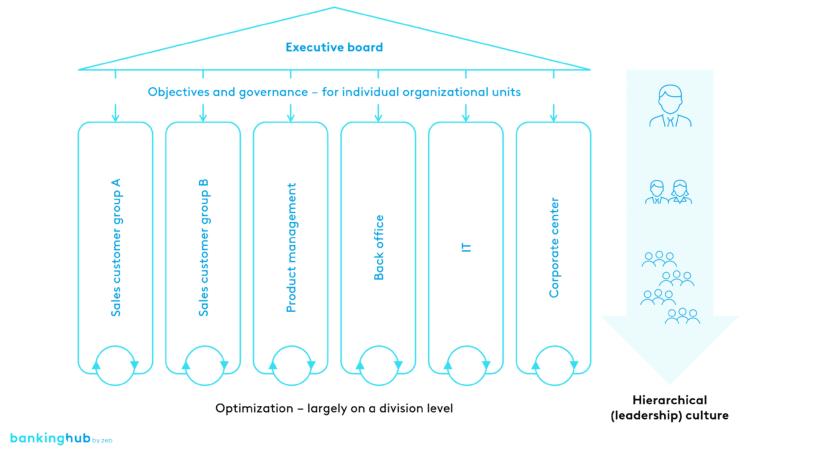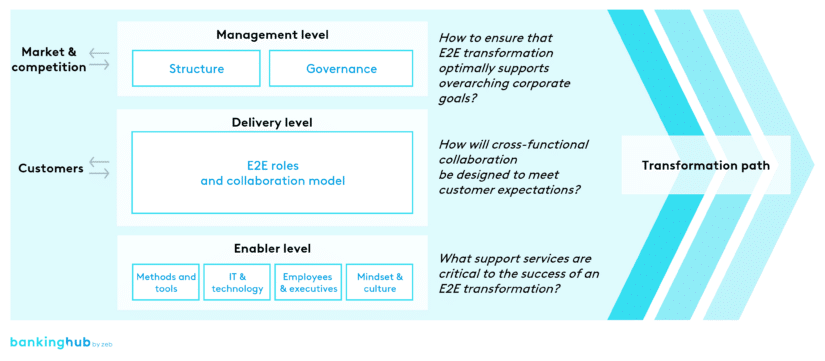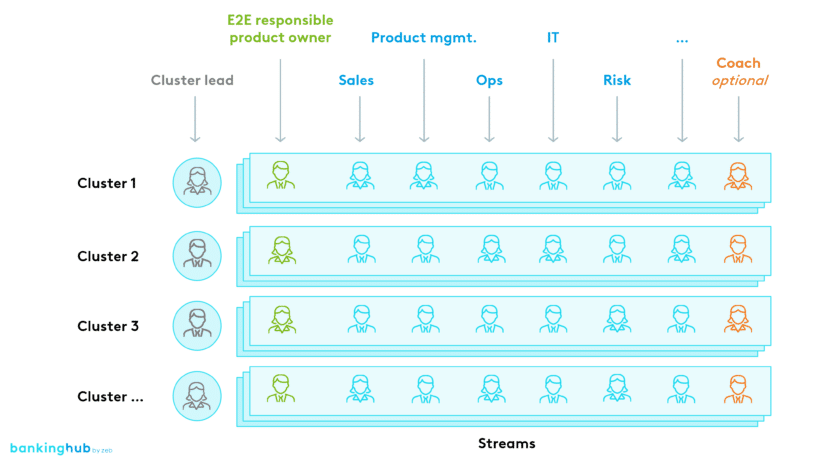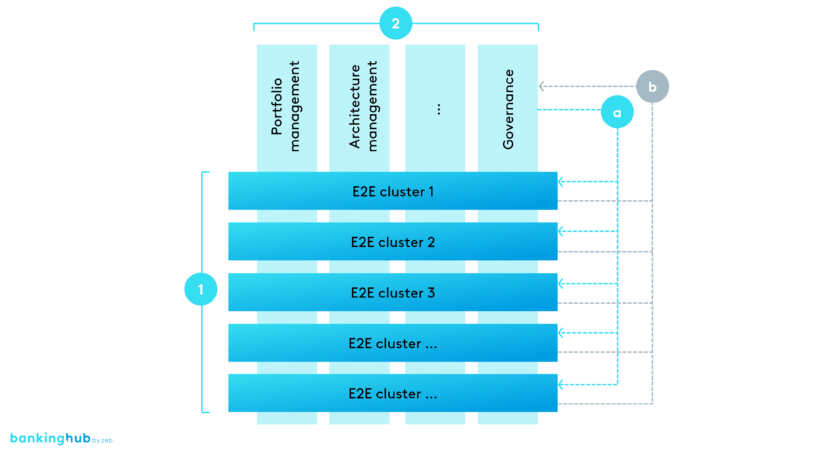Why is E2E transformation important?
Bank customers expect smooth and high-performance solutions at the push of a button. They no longer want just the banking product itself, but also a pleasant experience along the entire customer journey. Traditional banks have to compete with fintech as well as big tech companies and identify new market trends at an early stage. However, many banks are still organized in a “silo-like” manner (illustrated in Figure 1).
This type of organizational structure is often inflexible, unprogressive and inwardly focused. In companies that are structured this way, processes are usually optimized on a division level – how these measures affect other divisions, business areas and customer needs is only taken into consideration afterwards, if at all. Budgets and other resources are distributed among individual organizational units, which makes it difficult to operate in a flexible and entrepreneurial manner.
Many financial services providers are introducing agile collaboration models to address these symptoms. But if they don’t adjust the organizational structure itself, they are often also “trapped” in silos or reach their limits by the time it comes to resource allocation. Introducing an agile organizational model could be an appropriate remedy. However, the conversion from a siloed to a completely agile form of organization is often too radical. It may unsettle employees and consequently not yield the desired results.
A more promising approach would be to embed agile and thus cross-functional collaboration models in an organizational structure divided into customer-oriented product or service clusters – a so-called E2E organization.
The individual clusters are responsible for products and services on an E2E basis, i.e. from customer need to service provision. This allows them to focus on the customers and their needs as well as effective and efficient service delivery. Central control mechanisms such as project portfolio management and budgeting ensure that the activities of all clusters contribute to the overarching corporate goals.
The transformation towards such an E2E organization is called E2E transformation. It affects almost all areas of financial services providers and goes well beyond the scope of mere restructuring measures. Last but not least, it requires a fundamental cultural change. On the basis of various transformation projects, zeb has developed a framework that helps to consider all facets of E2E transformation and thus serves as a clear guideline from conceptual design to implementation.
How to organize E2E transformation
A successful E2E transformation of an organization has to happen on three different levels and under consideration of an overall transformation path.
- The management level covers all structuring and controlling elements.
- On the delivery level, the roles and the collaboration model are defined.
- The enabler level includes services that support the organization in implementing the transformation and the new operating model.
The transformation has to happen on all three levels, following the transformation path that is tailored to the specific company situation (see Figure 2).
Delivery level
On the delivery level, the focus is on roles and the collaboration model, which follow principles of agility (see Figure 3 for an overview). In large companies with multiple products, it is crucial to precisely define the profiles of the individual E2E clusters, i.e. which E2E process chains fulfill which customer needs.
Each E2E cluster has a modular structure and is headed by a cluster lead. A cluster lead may be responsible for several products belonging to their cluster, including both run and change responsibilities. They should be able to cope with this high degree of responsibility and thus ideally be recruited from the ranks of management. Their role is to coordinate the individual E2E teams.
Each cluster is subject to several E2E streams, which can, for example, be classified by products. For example, a “financing” cluster could be subdivided into “real estate loan”, “installment loan”, etc. As part of the budget responsibility, the cluster lead is responsible for prioritizing the individual budget resources for the respective streams. In order to do that, they need to identify the development potentials of the individual streams and allocate the available budget accordingly. How the budgets are used is decided autonomously within the individual streams.
Each E2E stream is headed by a product owner who can be held accountable for their respective stream. Product owners report to the cluster lead and are responsible for the success of their respective product. Their role is to prioritize the requirements specific to their stream. Product owners should be knowledgeable about and highly interested in designing and improving processes.
The remainder of each stream’s team ought to be cross-functional. Each stream should be made up of employees from various departments, including sales staff who know the customer needs as well as risk management and controlling staff. The goal of each cross-functional team is to continuously improve their stream with a particular focus on the dovetailing of specialist departments and IT. As part of the E2E stream, IT managers play an important role in increasing delivery capability. Their task is to react quickly to changing technical requirements.
Consulting one or several coaches might be a useful step when introducing the collaboration model as well as when an E2E stream reaches a certain magnitude. A coach may support the team with their methodological skills (e.g. Scrum, Design Thinking, OKR) and can react to potential disruptions and deviations in a moderating manner at an early stage.
Management level
For the delivery level to be practically viable, it must be embedded in an appropriate and supportive corporate structure (see Figure 4). The clusters described above form the organization, which is framed by overarching functions for managing the clusters.
The overarching functions ensure that all E2E clusters contribute to the company’s success and manage them in a targeted manner.
- The autonomy of the clusters (1) bears the risk that not all activities are directed towards the overarching corporate goals.
- This can be counteracted by a structure-providing framework of the organization (2).
- This sort of framework encompasses strategic portfolio management, architecture management, and main corporate center functions such as finance and HR.
- Within the framework, among other things, change measures are prioritized based on market potential and customer requirements, budgets are allocated to the individual clusters and the performance measuring methodology is defined (a).
- The individual E2E clusters are responsible for defining and regularly reporting on their KPIs (b), which allows to manage them appropriately.
Enabler level
For optimal implementation of the E2E organization, clusters need to be equipped with the right tools and capabilities. Those enablers are critical to the success of the E2E transformation and must be adjusted and provided in a way that suits the respective company best.
On the one hand, companies should consider classic (agile) methods and tools such as Scrum, Design Thinking or OKR. These formats help to structure and channel collaboration within the autonomous clusters. They should be supported by technological solutions. However, this does not only include suitable software solutions for collaboration, but also flexible as well as a scalable IT and overall technology infrastructure with modularizable systems.
On the other hand, those methods and systems are worthless without any changes of the mindset. A mindset and a culture that allows for feedback to be given and mistakes to be made in combination with a corresponding understanding of leadership will significantly increase trust among employees. This encouragement together with the autonomy and ownership given to the individual clusters and streams, is the key to success.
At the same time, employees must embrace the idea of working with more personal responsibility, which is something that has to be learned over time. In that regard, it is possible to make use of beneficial pull effects by allowing for easy-to-achieve successes as a “proof of concept”. Recognizing the significance of these rather soft factors will remove most of the potential hurdles in an E2E transformation process.
Transformation path
The E2E transformation must be implemented on all three levels simultaneously. A pure focus on, for example, the delivery level will not yield the desired results, as important control mechanisms and enablers would be missing.
Following the guiding principle of “revolutionary target picture and evolutionary implementation” will result in a broad target picture that can be achieved in increments. The pace of transformation to a great extent depends on the chosen approach: A radical approach can result in a faster transformation process. However, such a top-down approach requires the full commitment of all executives and often leads to internal resistance.
In contrast, a sequential transformation may emerge from a specific project or a group of executives deciding to promote such a transformation process. This allows for gradual aligned changes of the entire company. Although this approach requires a longer implementation period, it allows for a cultural change from within. Sequential transformation processes can be managed more effectively due to learning effects along the way, thus ensuring the necessary acceptance within the organization and among its employees.
BankingHub-Newsletter
Analyses, articles and interviews about trends & innovation in banking delivered right to your inbox every 2-3 weeks
"(Required)" indicates required fields
How to ensure a successful transformation
The presented framework helps to take all facets of an E2E transformation into consideration. However, in order to ensure a successful transformation and promote customer orientation, efficiency and entrepreneurship in the long term, various success factors should be taken into account. Some of the most important among these factors are:
- “Demanding commitment”: An E2E transformation process requires executives to be willing to relinquish some of their responsibilities or take over new ones and break down silos – that makes management commitment the core success factor in E2E transformation.
- “Making it tangible”: The advantages of the E2E transformation must be evident for all employees from the very beginning. During the transformation process, they should be able to first-hand experience these advantages. To achieve this, executives and employees alike should have the opportunity to shape the transformation via (agile) sprints (within a fixed framework and with a defined toolbox).
- “Finding the sweet spot”: For a smooth cooperation in the delivery organization, the E2E cluster structure should be tailored to suit the respective financial services provider.
- “Pursuing shared goals”: Team goals should be developed collaboratively to make sure executives and employees are equally committed. “Encouraging entrepreneurship” should be one of the most important goals of the resulting (flexible) incentive system.
- “Allowing mistakes to happen”: Consistently promoting a culture that allows for mistakes to happen gives executives as well as employees the security they need to assume entrepreneurial responsibility and even more importantly inspires them to do so.
- “Learning from pilot projects”: Selected clusters/products should be launched in pilot projects. This allows initial successes and a proof of concept to be achieved and lessons to be learned for the subsequent rollout – either according to top-down or bottom-up principles.
The above-mentioned success factors show that the success of an E2E transformation depends to a certain degree on the right tailoring of the clusters, the definition of collaboration models and other conceptual aspects, but even more important are the rather soft factors that enable a fundamental change in company culture.










